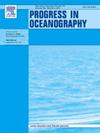Responses of Subantarctic mode water spreading to Southern Annular Mode in Southern Indian Ocean
IF 3.6
3区 地球科学
Q1 OCEANOGRAPHY
引用次数: 0
Abstract
The Subantarctic Mode Water (SAMW) is a voluminous water mass with relatively uniform physical properties in the Southern Ocean and plays an important role in ocean heat uptake, transport, and storage. Based on Argo observations, this study investigates how the spreading of Southeast Indian Subantarctic Mode Water (SEISAMW) responds to the Southern Annular Mode (SAM). The results show that the meridional shift of the outcrop line, which controls the variations of SEISAMW spreading, is closely linked to the SAM index. This shift is dominated by the SAM-related Ekman transport and surface flux. During positive phase of SAM, in response to the weakening of westerlies in the central of Southern Indian Ocean, where lighter (26.6–26.7 σθ) SEISAMW forms, the latent heat loss is reduced and Ekman heat transport exhibits positive anomalies, leading to the increase of sea surface temperature (SST). As a result, the outcrop line shifts poleward, which favors less lighter SEISAMW spreading into subtropical gyre. Meanwhile, the southwest wind anomaly south of Australia, where denser (26.7–26.9 σθ) SEISAMW forms, brings the cold dry air from higher latitudes and leads to the enhanced evaporation, combined with reduced precipitation, resulting in the increased sea surface salinity (SSS). Consequently, the outcrop line shifts equatorward, which favors more denser SEISAMW spreading into subtropical gyre. The opposite occurs during negative phase of SAM.
南印度洋亚南极模态水向南环状模态扩散的响应
亚南极模态水(SAMW)是南大洋中具有相对均匀物理性质的大量水团,在海洋热吸收、运输和储存中起着重要作用。基于Argo观测资料,研究了东南印度亚南极模态水(SEISAMW)的扩散对南环模态(SAM)的响应。结果表明,控制SEISAMW扩散变化的露头线经向移动与SAM指数密切相关。这种转移主要是由sam相关的Ekman输运和地表通量控制的。在SAM正相位,响应南印度洋中部西风带减弱,形成较轻(26.6 ~ 26.7 σθ)的SEISAMW,潜热损失减少,Ekman热输运出现正异常,导致海表温度升高。其结果是,露头线向极地移动,有利于较小的SEISAMW向副热带环流扩散。同时,澳大利亚南部的西南风异常形成较密集(26.7 ~ 26.9 σθ)的SEISAMW,带来高纬度的冷干空气,导致蒸发增强,降水减少,海面盐度(SSS)升高。因此,露头线向赤道移动,有利于更密集的SEISAMW向副热带环流扩散。在SAM的负相则相反。
本文章由计算机程序翻译,如有差异,请以英文原文为准。
求助全文
约1分钟内获得全文
求助全文
来源期刊

Progress in Oceanography
地学-海洋学
CiteScore
7.20
自引率
4.90%
发文量
138
审稿时长
3 months
期刊介绍:
Progress in Oceanography publishes the longer, more comprehensive papers that most oceanographers feel are necessary, on occasion, to do justice to their work. Contributions are generally either a review of an aspect of oceanography or a treatise on an expanding oceanographic subject. The articles cover the entire spectrum of disciplines within the science of oceanography. Occasionally volumes are devoted to collections of papers and conference proceedings of exceptional interest. Essential reading for all oceanographers.
 求助内容:
求助内容: 应助结果提醒方式:
应助结果提醒方式:


